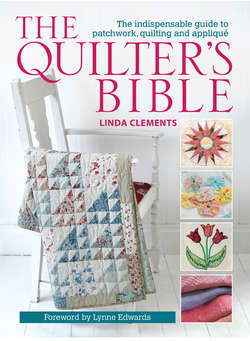Читать книгу The Quilter's Bible - Linda - Страница 9
На сайте Литреса книга снята с продажи.
Design Tools
ОглавлениеThere are various items that are useful for drafting and designing in many areas of patchwork, appliqué and quilting. See Drawing and Cutting Shapes for more on drawing shapes.
• Geometry tools (1) – A compass is needed for drawing circles and semi-circles, a protractor for measuring angles and drafting triangles and a standard ruler with 1⁄8in (3mm) and 1⁄16in (1.5mm) markings for drawing shapes.
• Colour wheel (2) – This will help with making colour choices when designing blocks and quilt settings, showing which colours are complementary and which are analogous – see Using Colour for more advice on colour.
• Multi-image lens (3) – This allows you to see multiplied images and thus imagine how grouped blocks might look.
• Value finder (4) – Red and green lenses can be used to show relative dark and light tones in fabrics.
• Pens and pencils – These will be needed for various tasks, including sketching design ideas, drafting shapes and blocks and creating templates. Coloured pens and pencils are useful for planning colour schemes.
• Papers – Various types of paper are useful, including plain paper for drawing ideas and sketches, graph paper for planning blocks and quilt layouts, isometric paper for drafting triangles, hexagons and diamonds, and tracing paper for copying designs and templates.
• Card – Sheets of card can be used for making templates and thin card is handy for English paper piecing.
• Calculator – When designing and working out fabric requirements, a calculator makes the maths much easier.
• Design board – Having somewhere to display work in progress is vital so you can judge how a design is working. This might be a piece of fabric fixed to a wall where work can be pinned, or a board that folds away when not in use. A closed curtain can be a temporary display area.
• Lighting equipment – It is important to have good lighting as you design or sew, to see the work properly and avoid straining your eyes. An overhead lamp with a head that can be angled is most useful and many are available with a magnifying attachment. Using a ‘daylight’ type bulb will help to produce real light conditions and make choosing thread colours easier.
